Community-Based Participatory Research on Urban Environmental Conflicts: Sand Quarries in Northern Bogotá
Abstract
1. Introduction
2. Methods
3. Results
3.1. Conflicts and Consequences
3.2. Actors, Actions, and Interactions
4. Discussion
5. Conclusions
Author Contributions
Funding
Data Availability Statement
Conflicts of Interest
References
- Bloodworth, A.J.; Scott, P.W.; McEvoy, F.M. Digging the backyard: Mining and quarrying in the UK and their impact on future land use. Land Use Policy 2009, 26, S317–S325. [Google Scholar] [CrossRef]
- Rivas, V.; Cendrero, A.; Hurtado, M.; Cabral, M.; Giménez, J.; Forte, L.; del Ríoe, L.; Cantúf, M.; Becker, A. Geomorphic consequences of urban development and mining activities; an analysis of study areas in Spain and Argentina. Geomorphology 2006, 73, 185–206. [Google Scholar] [CrossRef]
- PNUD; UN-Habitat; CENAC. Cuadernos PNUD-UN Hábitat: Hábitat Y Desarrollo Humano”; Cuadernos PNUD—UN Habitat Investigaciones Sobre Desarrollo Humano; PNUD: New York, NY, USA, 2004. [Google Scholar]
- Vaidya, H.; Chatterji, T. SDG 11 sustainable cities and communities: SDG 11 and the new urban agenda: Global sustainability frameworks for local action. In Actioning the Global Goals for Local Impact: Towards Sustainability Science, Policy, Education and Practice; Springer Nature: Singapore, 2020; pp. 173–185. [Google Scholar]
- del Hoyo, R.P.; Visvizi, A.; Mora, H. Inclusiveness, safety, resilience, and sustainability in the smart city context. In Smart Cities and the UN SDGs; Elsevier: Amsterdam, The Netherlands, 2021; pp. 15–28. [Google Scholar]
- Belsky, E.S.; DuBroff, N.; McCue, D.; Harris, C.; McCartney, S.; Molinsky, J. Advancing Inclusive and Sustainable Urban Development: Correcting Planning Failures and Connecting Communities to Capital; Joint Center for Housing Studies of Harvard University: Cambridge, MA, USA, 2013. [Google Scholar]
- Elias, P. Inclusive city, perspectives, challenges, and pathways. In Sustainable Cities and Communities; Springer International Publishing: Cham, Switzerland, 2020; pp. 290–300. [Google Scholar]
- Tate, C.; Wang, R.; Akaraci, S.; Burns, C.; Garcia, L.; Clarke, M.; Hunter, R. The contribution of urban green and blue spaces to the United Nation’s sustainable development goals: An evidence gap map. Cities 2024, 145, 104706. [Google Scholar] [CrossRef]
- Haughton, G.; Hunter, C. Sustainable Cities; Routledge: Philadelphia, PA, USA, 2004. [Google Scholar]
- Ruiz, G.A.Q.; Kotilainen, J.; Salo, M. Reterritorialization practices and strategies of campesinos in the urban frontier of Bogotá, Colombia. Land Use Policy 2020, 99, 105058. [Google Scholar] [CrossRef]
- Reyes-Riveros, R.; Altamirano, A.; De La Barrera, F.; Rozas-Vásquez, D.; Vieli, L.; Meli, P. Linking public urban green spaces and human well-being: A systematic review. Urban For. Urban Green. 2021, 61, 127105. [Google Scholar] [CrossRef]
- Jabbar, M.; Yusoff, M.M.; Shafie, A. Assessing the role of urban green spaces for human well-being: A systematic review. GeoJournal 2021, 87, 4405–4423. [Google Scholar] [CrossRef]
- Bertram, C.; Rehdanz, K. The role of urban green space for human well-being. Ecol. Econ. 2015, 120, 139–152. [Google Scholar] [CrossRef]
- Panagopoulos, T.; Duque, J.A.G.; Dan, M.B. Urban planning with respect to environmental quality and human well-being. Environ. Pollut. 2016, 208, 137–144. [Google Scholar] [CrossRef] [PubMed]
- Lafortezza, R.; Carrus, G.; Sanesi, G.; Davies, C. Benefits and well-being perceived by people visiting green spaces in periods of heat stress. Urban For. Urban Green. 2009, 8, 97–108. [Google Scholar] [CrossRef]
- Friederich, J.; Langer, H. Índice de Ciudades Verdes de América Latina: Una Evaluación Comparativa del Impacto Ecológico de las Principales Ciudades de América Latina; Economist Intelligence Unit, Siemens AG: Munich, Germany, 2010; Available online: http://plataforma.responsable.net/sites/default/files/indice_de_ciudades_verdes_de_america_latina.pdf (accessed on 10 July 2020).
- Anselm, N.; Brokamp, G.; Schütt, B. Assessment of land cover change in peri-urban high Andean environments South of Bogotá, Colombia. Land 2018, 7, 75. [Google Scholar] [CrossRef]
- Dudka, S.; Adriano, D.C. Environmental impacts of metal ore mining and processing: A review. J. Environ. Qual. 1997, 26, 590–602. [Google Scholar] [CrossRef]
- McIntyre, N.; Angarita, M.; Fernandez, N.; Camacho, L.A.; Pearse, J.; Huguet, C.; Baena, O.J.R.; Ossa-Moreno, J. A framework for assessing the impacts of mining development on regional water resources in Colombia. Water 2018, 10, 268. [Google Scholar] [CrossRef]
- Suarez, A.; Árias-Arévalo, P.A.; Martínez-Mera, E. Environmental sustainability in post-conflict countries: Insights for rural Colombia. Environ. Dev. Sustain. 2018, 20, 997–1015. [Google Scholar] [CrossRef]
- Prieto, A.V.; García-Estévez, J.; Ariza, J.F. On the relationship between mining and rural poverty: Evidence for Colombia. Resour. Policy 2022, 75, 102443. [Google Scholar] [CrossRef]
- Özkaynak, B.; Rodríguez-Labajos, B.; Arsel, M.; Avci, D.; Carbonell, M.H.; Chareyron, B.; Yánez, I. Mining conflicts around the world: Common grounds from an environmental justice perspective. In Ecological Integrity and Global Governance: Science, Ethics and the Law; Westra, L., Gray, J., Gottwald, M., Eds.; Earthscan: Oxford, UK, 2012; pp. 95–112. [Google Scholar]
- Carvalho, F.P. Mining industry and sustainable development: Time for change. Food Energy Secur. 2017, 6, 61–77. [Google Scholar] [CrossRef]
- Hacker, K.; Tendulkar, S.A.; Rideout, C.; Bhuiya, N.; Trinh-Shevrin, C.; Savage, C.P.; Grullon, M.; Strelnick, H.; Leung, C.; DiGirolamo, A. Community capacity building and sustainability: Outcomes of community-based participatory research. Prog. Community Health Partnersh. Res. Educ. Action 2012, 6, 349–360. [Google Scholar] [CrossRef]
- Coughlin, S.S.; Smith, S.A.; Fernández, M.E. (Eds.) Handbook of Community-Based Participatory Research; Oxford University Press: Oxford, UK, 2017. [Google Scholar]
- Liebman, M.; Paulston, R.G. Social cartography: A new methodology for comparative studies. Compare 1994, 24, 233–245. [Google Scholar] [CrossRef]
- Gavriletea, M.D. Environmental impacts of sand exploitation. Analysis of sand market. Sustainability 2017, 9, 1118. [Google Scholar] [CrossRef]
- Saviour, M.N. Environmental impact of soil and sand mining: A review. Int. J. Sci. Environ. Technol. 2012, 1, 125–134. [Google Scholar]
- Rentier, E.S.; Cammeraat, L.H. The environmental impacts of river sand mining. Sci. Total Environ. 2022, 838, 155877. [Google Scholar] [CrossRef]
- Kalibo, H.W.; Medley, K.E. Participatory resource mapping for adaptive collaborative management at Mt. Kasigau, Kenya. Landsc. Urban Plan. 2007, 82, 145–158. [Google Scholar] [CrossRef]
- Brown, G.; Raymond, C.M. Methods for identifying land use conflict potential using participatory mapping. Landsc. Urban Plan. 2014, 122, 196–208. [Google Scholar] [CrossRef]
- Ernstson, H. The social production of ecosystem services: A framework for studying environmental justice and ecological complexity in urbanized landscapes. Landsc. Urban Plan. 2013, 109, 7–17. [Google Scholar] [CrossRef]
- McHale, M.R.; Pickett, S.T.; Barbosa, O.; Bunn, D.N.; Cadenasso, M.L.; Childers, D.L.; Gartin, M.; Hess, G.R.; Iwaniec, D.M.; McPhearson, T.; et al. The new global urban realm: Complex, connected, diffuse, and diverse social-ecological systems. Sustainability 2015, 7, 5211–5240. [Google Scholar] [CrossRef]
- Portugali, J.; Meyer, H.; Stolk, E.; Tan, E. (Eds.) Complexity Theories of Cities Have Come of Age: An Overview with Implications to Urban Planning and Design; Springer Science & Business Media: Berlin/Heidelberg, Germany, 2012. [Google Scholar]
- Walker, G.B. Public participation as participatory communication in environmental policy decision-making: From concepts to structured conversations. Environ. Commun. 2007, 1, 99–110. [Google Scholar] [CrossRef]
- Chu, E.; Anguelovski, I.; Carmin, J. Inclusive approaches to urban climate adaptation planning and implementation in the Global South. Clim. Policy 2015, 16, 372–392. [Google Scholar] [CrossRef]
- Wheeler, S. Planning for Sustainability: Creating Livable, Equitable, and Ecological Communities; Routledge: Philadelphia, PA, USA, 2013. [Google Scholar]
- Natarajan, L. Socio-spatial learning: A case study of community knowledge in participatory spatial planning. Prog. Plan. 2017, 111, 1–23. [Google Scholar] [CrossRef]
- Shandas, V.; Messer, W.B. Fostering green communities through civic engagement: Community-based environmental stewardship in the Portland area. J. Am. Plan. Assoc. 2008, 74, 408–418. [Google Scholar] [CrossRef]
- Fisher, D.; Svendsen, E.; Connolly, J. Urban Environmental Stewardship and Civic Engagement: How Planting Trees Strengthens the Roots of Democracy; Routledge: Philadelphia, PA, USA, 2015. [Google Scholar]
- Amorim-Maia, A.T.; Anguelovski, I.; Chu, E.; Connolly, J. Intersectional climate justice: A conceptual pathway for bridging adaptation planning, transformative action, and social equity. Urban Clim. 2022, 41, 101053. [Google Scholar] [CrossRef]
- Bertella, G.; Lupini, S.; Romanelli, C.R.; Font, X. Workshop methodology design: Innovation-oriented participatory processes for sustainability. Ann. Tour. Res. 2021, 89, 103251. [Google Scholar] [CrossRef]
- Watson, V. Learning to Liberate: Community-Based Solutions to the Crisis in Urban Education; Routledge: Philadelphia, PA, USA, 2012. [Google Scholar]
- Panek, J.; Netek, R. Collaborative mapping and digital participation: A tool for local empowerment in developing countries. Information 2019, 10, 255. [Google Scholar] [CrossRef]
- Brown, G.; Kyttä, M. Key issues and priorities in participatory mapping: Toward integration or increased specialization? Appl. Geogr. 2018, 95, 1–8. [Google Scholar] [CrossRef]
- Malakar, K.D.; Roy, S. Community Cartography and Participatory GIS. In Mapping Geospatial Citizenship: The Power of Participatory GIS; Springer Nature: Cham, Switzerland, 2024; pp. 61–72. [Google Scholar]
- Warren, J.Y. Grassroots Mapping: Tools for Participatory and Activist Cartography. Ph.D. Thesis, Massachusetts Institute of Technology, Cambridge, MA, USA, 2010. [Google Scholar]
- Michael, N.; Shen, S.; Mohta, K.; Kumar, V.; Nagatani, K.; Okada, Y.; Tadokoro, S. Collaborative mapping of an earthquake damaged building via ground and aerial robots. In Field and Service Robotics: Results of the 8th International Conference; Springer: Berlin/Heidelberg, Germany, 2014; pp. 33–47. [Google Scholar]
- Adams, W.C. Conducting semi-structured interviews. In Handbook of Practical Program Evaluation, 3rd ed.; Wholey, J.S., Hatry, H.P., Newcomer, K.E., Eds.; Jossey-Bass: San Francisco, CA, USA, 2015; pp. 492–505. [Google Scholar]
- Porto-Gonçalves, C.W.; Leff, E. Political ecology in Latin America: The social re-appropriation of nature, the reinvention of territories and the construction of an environmental rationality. Desenvolv. E Meio Ambiente 2015, 35, 65–88. [Google Scholar] [CrossRef]
- Greider, T.; Garkovich, L. Landscapes: The social construction of nature and the environment. Rural. Sociol. 1994, 59, 1–24. [Google Scholar] [CrossRef]
- Demeritt, D. What is the ‘social construction of nature’? A typology and sympathetic critique. Prog. Hum. Geogr. 2002, 26, 767–790. [Google Scholar] [CrossRef]
- Wilson, T.M.; Donnan, H. Territory, identity and the places in-between: Culture and power in European borderlands. In Culture and Power at the Edges of the State: National Support and Subversion in European Border Regions; Donnan, H., Wilson, T.M., Eds.; National Museum of Ethnology: Osaka, Japan, 2005; pp. 1–31. [Google Scholar]
- Lawrence, D.L.; Low, S.M. The built environment and spatial form. Annu. Rev. Anthropol. 1990, 19, 453–505. [Google Scholar] [CrossRef]
- Kaplan, D.H. Territorial identities and geographic scale. In Nested Identities: Nationalism, Territory and Scale; Keating, M.J., Ed.; Rowman & Littlefield Publishers: Lanham, MD, USA, 1999; pp. 31–49. [Google Scholar]
- Capello, R. Interpreting and understanding territorial identity. Reg. Sci. Policy Pract. 2019, 11, 141–159. [Google Scholar] [CrossRef]
- Sletto, B.I. We drew what we imagined” participatory mapping, performance, and the arts of landscape making. Curr. Anthropol. 2009, 50, 443–476. [Google Scholar] [CrossRef]
- Schroeder, H.W. Place experience, gestalt, and the human–nature relationship. J. Environ. Psychol. 2007, 27, 293–309. [Google Scholar] [CrossRef]
- Schultz, P.W. Inclusion with nature: The psychology of human-nature relations. In Psychology of Sustainable Development; Schmuck, P., Schultz, P.W., Eds.; Springer: Boston, MA, USA, 2002; pp. 61–78. [Google Scholar]
- Escobar, A. Whose knowledge, whose nature? Biodiversity, conservation, and the political ecology of social movements. J. Political Ecol. 1998, 5, 53–82. [Google Scholar]
- Kuusisto, A.K. Territoriality, symbolism and the challenge. Peace Rev. 2001, 13, 59–66. [Google Scholar] [CrossRef]
- Rozzi, R. Biocultural ethics: Recovering the vital links between the inhabitants, their habits, and habitats. Environ. Ethics 2012, 34, 27. [Google Scholar] [CrossRef]
- Fals-Borda, O.; Moncayo, V.M. “Una Sociología Sentipensante para América Latina”; Siglo del Hombre: Bogotá, Colombia, 2009. [Google Scholar]
- Ortiz, M.; Borjas, B. “La Investigación Acción Participativa: Aporte de Fals Borda a la educación popular”. Espac. Abierto 2008, 17, 615–627. [Google Scholar]
- Schubert, J. Environmental Adaptation and Eco-Cultural Habitats: A Coevolutionary Approach to Society and Nature; Routledge: Philadelphia, PA, USA, 2015. [Google Scholar]
- Alberich-Nistal, T. La Investigación Acción Participación, Método y Práctica. In Memorias del IV Congreso Internacional Sobre Investigación; Acción Participativa: Valladolid, España, 2007; p. 10. [Google Scholar]
- Perkins, D.D.; Brown, B.B.; Taylor, R.B. The ecology of empowerment: Predicting participation in community organizations. J. Soc. Issues 1996, 52, 85–110. [Google Scholar] [CrossRef]
- Klaar, S.; Öhman, J. Doing, knowing, caring and feeling: Exploring relations between nature-oriented teaching and preschool children’s learning. Int. J. Early Years Educ. 2014, 22, 37–58. [Google Scholar] [CrossRef]
- Dernikos, B.P.; Lesko, N.; McCall, S.D.; Niccolini, A.D. Feeling education. In Mapping the Affective Turn in Education; Routledge: Philadelphia, PA, USA, 2020; pp. 3–27. [Google Scholar]
- Kindon, S.; Pain, R.; Kesby, M. Participatory action research: Origins, approaches and methods. In Participatory Action Research Approaches and Methods; Routledge: Philadelphia, PA, USA, 2007; pp. 35–44. [Google Scholar]
- Fine, M.; Torre, M.E.; Oswald, A.G.; Avory, S. Critical participatory action research: Methods and praxis for intersectional knowledge production. J. Couns. Psychol. 2021, 68, 344. [Google Scholar] [CrossRef]
- Savin-Baden, M.; Wimpenny, K. Exploring and implementing participatory action research. J. Geogr. High. Educ. 2007, 31, 331–343. [Google Scholar] [CrossRef]
- Moore, S.A.; Brown, G.; Kobryn, H.; Strickland-Munro, J. Identifying conflict potential in a coastal and marine environment using participatory mapping. J. Environ. Manag. 2017, 197, 706–718. [Google Scholar] [CrossRef]
- Gray, L.C. Environmental policy, land rights, and conflict: Rethinking community natural resource management programs in Burkina Faso. Environ. Plan. D Soc. Space 2002, 20, 167–182. [Google Scholar] [CrossRef]
- Santos, M.A.D.L.; Sol, N.A.A.; Modena, C.M. Territory and deterritorialization: The social suffering by environmental disaster resulting from the breaking of mining dams. Saúde em Debate 2021, 44, 262–271. [Google Scholar] [CrossRef]
- Widayat, Y.Y.; Karlina, N.; Munajat, M.D.E.; Ningrum, S. Mapping policy actors using social network analysis on integrated urban farming program in Bandung City. Sustainability 2023, 15, 9612. [Google Scholar] [CrossRef]
- Bodin, Ö.; Crona, B.I. The role of social networks in natural resource governance: What relational patterns make a difference? Glob. Environ. Chang. 2009, 19, 366–374. [Google Scholar] [CrossRef]
- Reyes-García, V.; Andrés-Conejero, O.; Fernández-Llamazares, Á.; Díaz-Reviriego, I.; Molina, J.L. A road to conflict: Stake-holder’s and social network analysis of the media portrayals of a social-environmental conflict in Bolivia. Soc. Nat. Resour. 2019, 32, 452–472. [Google Scholar] [CrossRef]
- Reed, M.S. Stakeholder participation for environmental management: A literature review. Biol. Conserv. 2008, 141, 2417–2431. [Google Scholar] [CrossRef]
- De Jonge, V.N.; Pinto, R.; Turner, R.K. Integrating ecological, economic and social aspects to generate useful management information under the EU Directives’ ‘ecosystem approach’. Ocean. Coast. Manag. 2012, 68, 169–188. [Google Scholar] [CrossRef]
- Fierro-Morales, J. Políticas Mineras en Colombia; Instituto Latinoamericano para una Sociedad y un Derecho Alternativos–ILSA: Bogotá, Colombia, 2012. [Google Scholar]
- Göbel, B.; Ulloa, A. Extractivismo Minero en Colombia y en América Latina; Biblioteca Abierta. Perspectivas Ambientales 429; Universidad Nacional de Colombia: Bogotá, Colombia, 2014. [Google Scholar]
- Personería de Bogotá, D.C. 92.6% de Minería En Bogotá Es Ilegal. 2012. Available online: http://www.personeriabogota.gov.co/archivo-2012/item/126-92-6-de-mineria-en-Bogotá-es-ilegal (accessed on 10 July 2020).
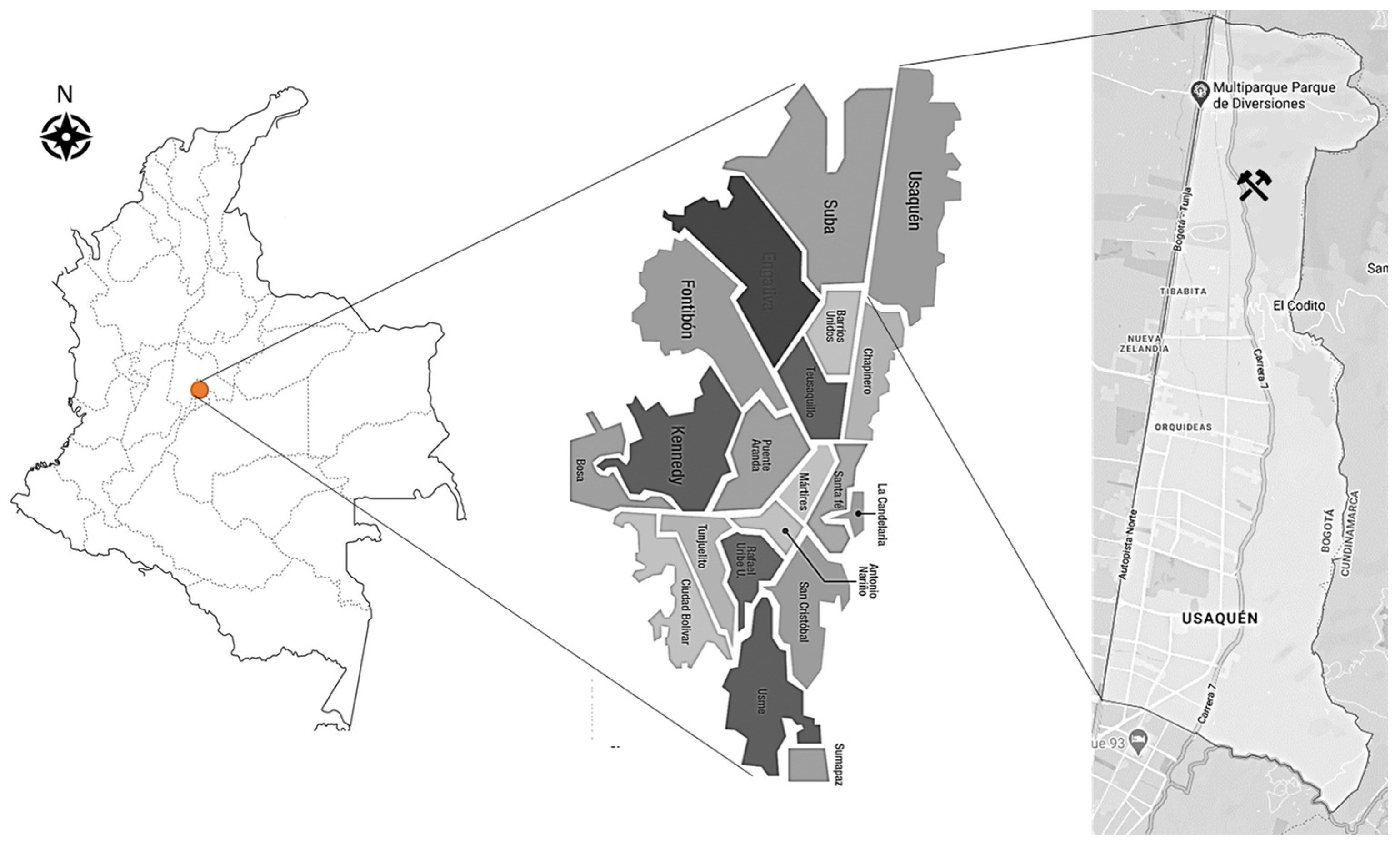
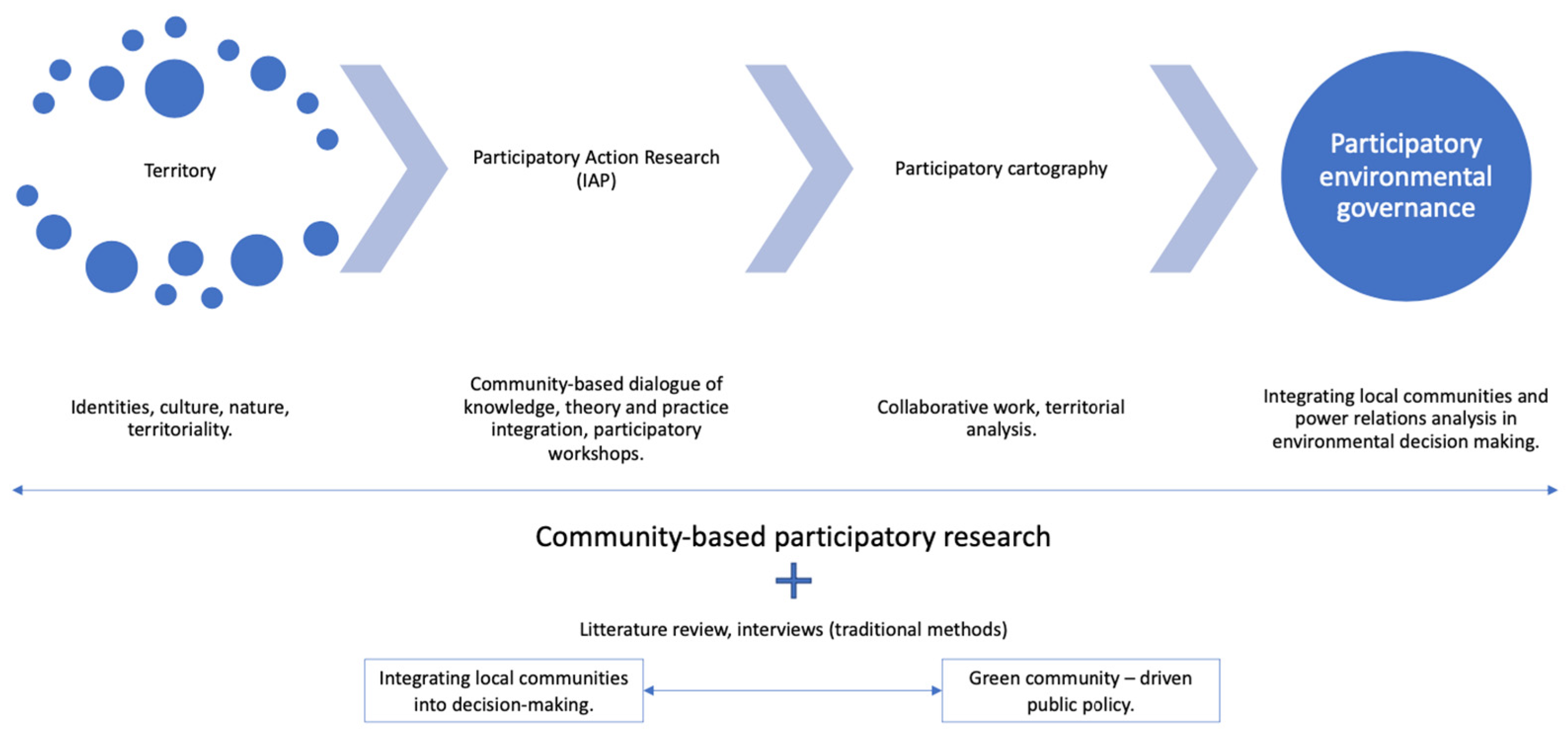
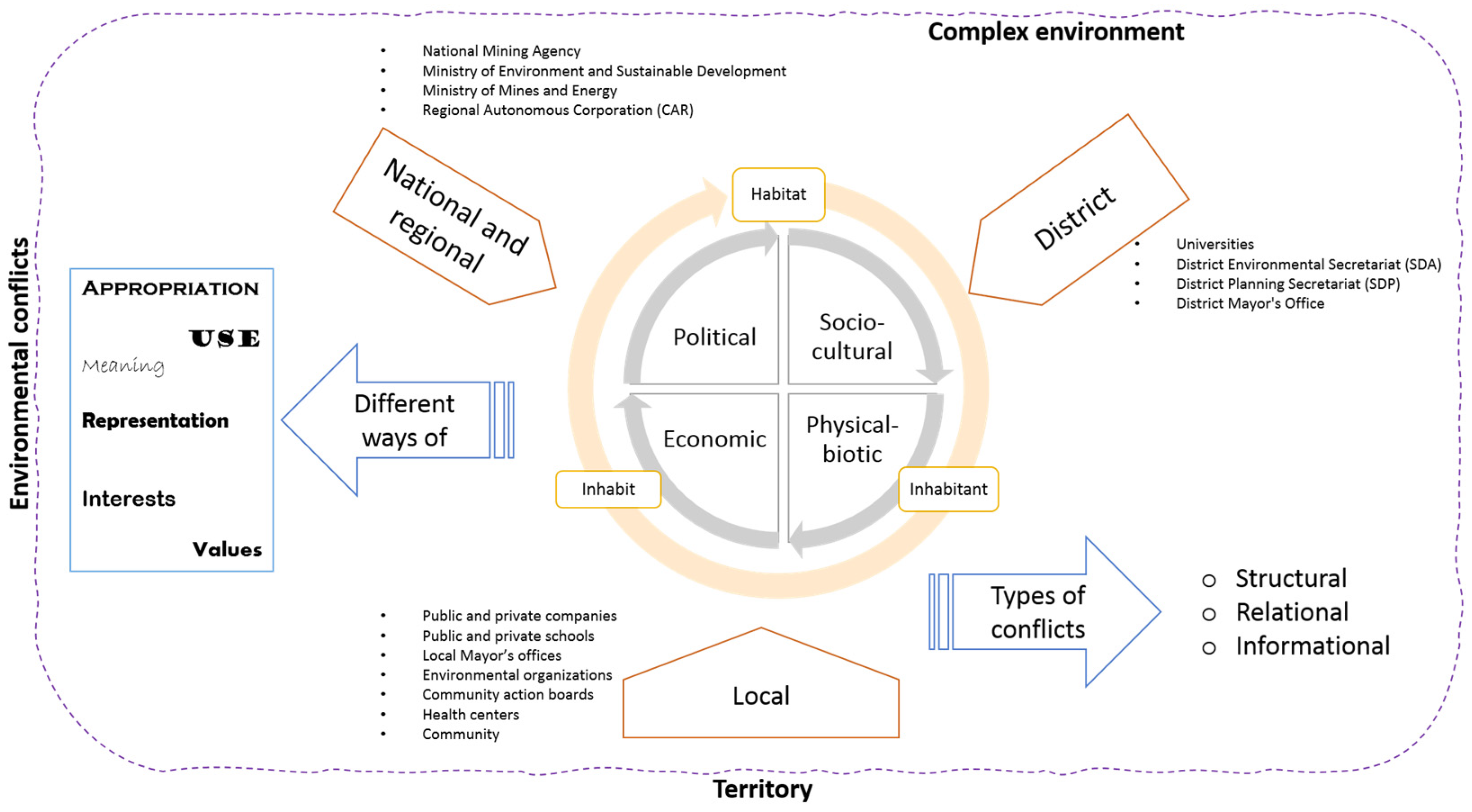
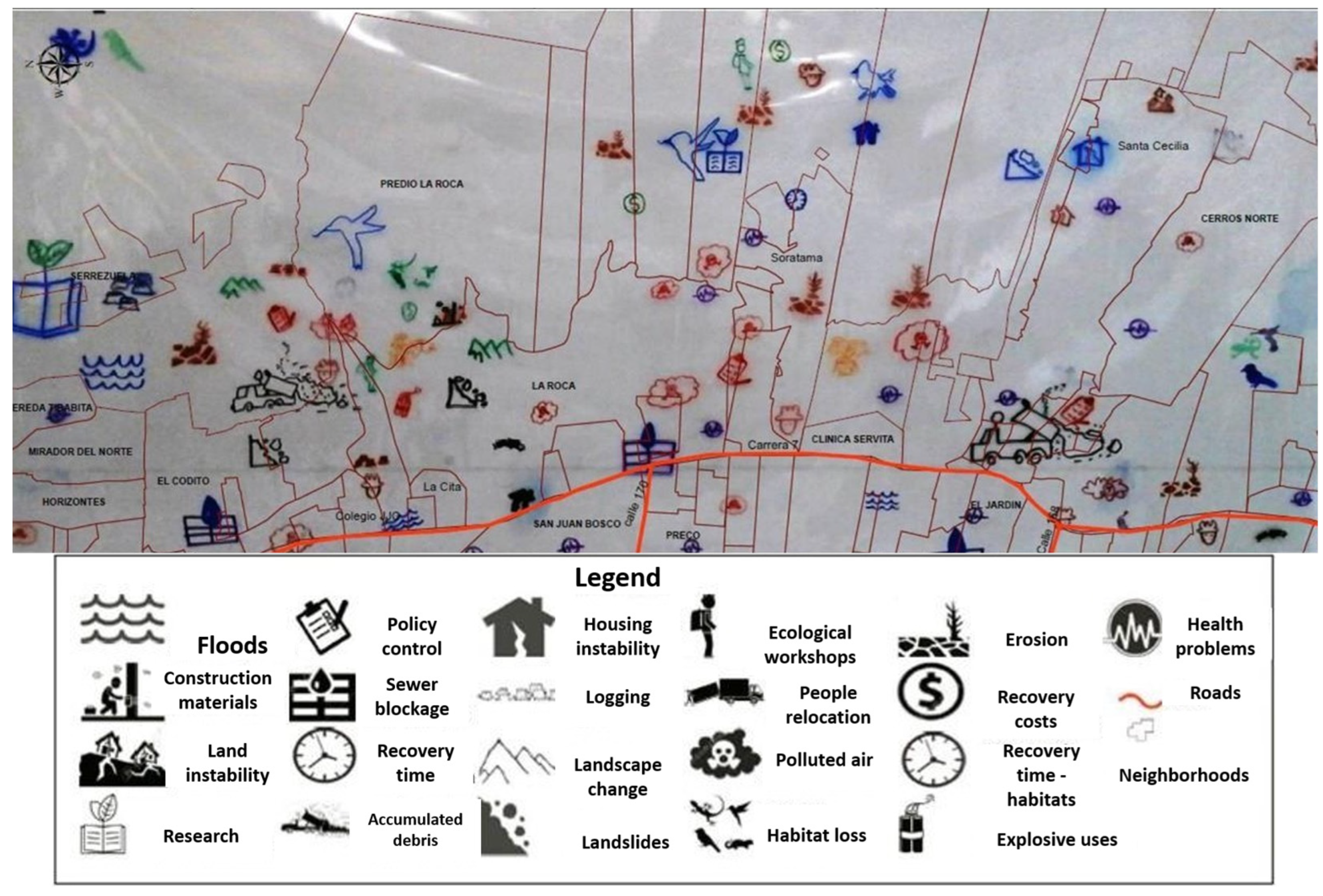

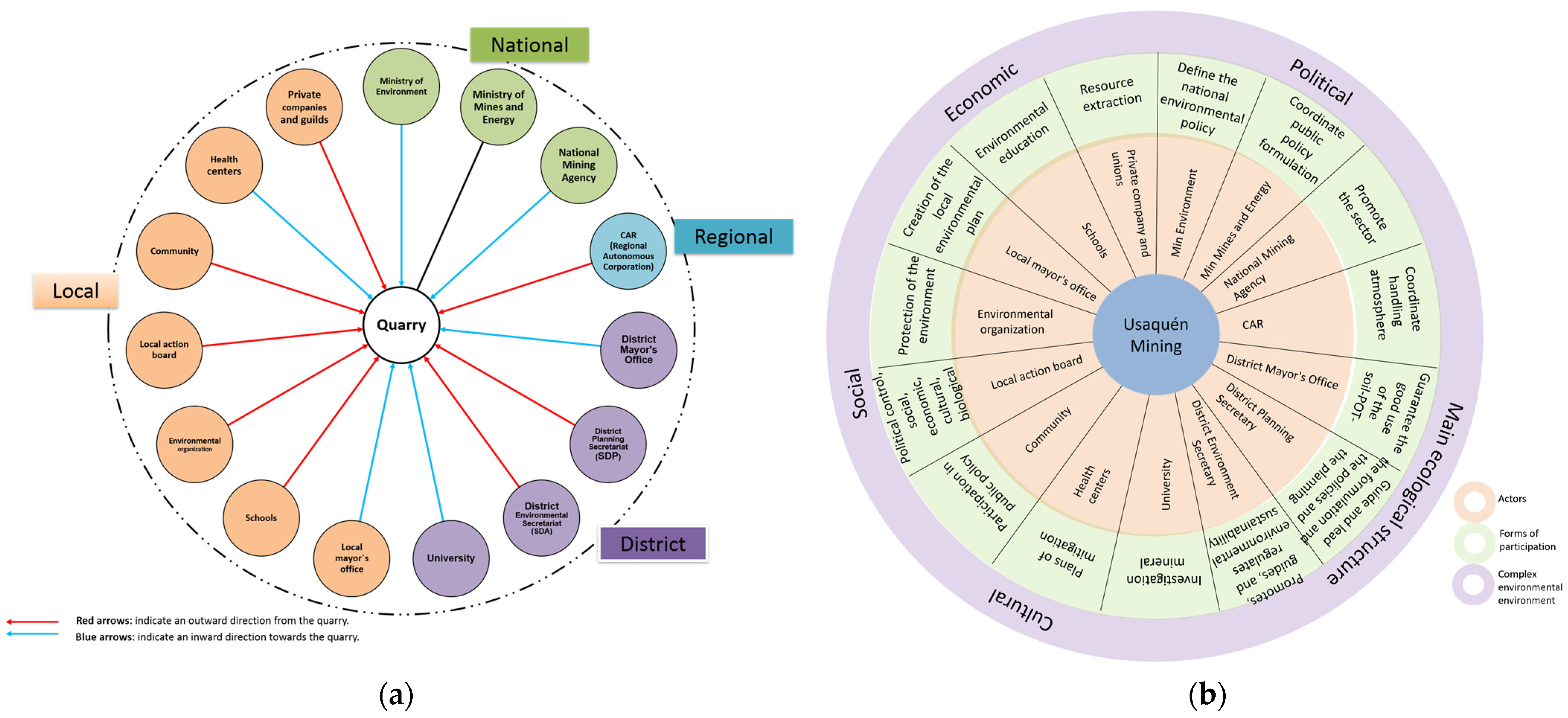
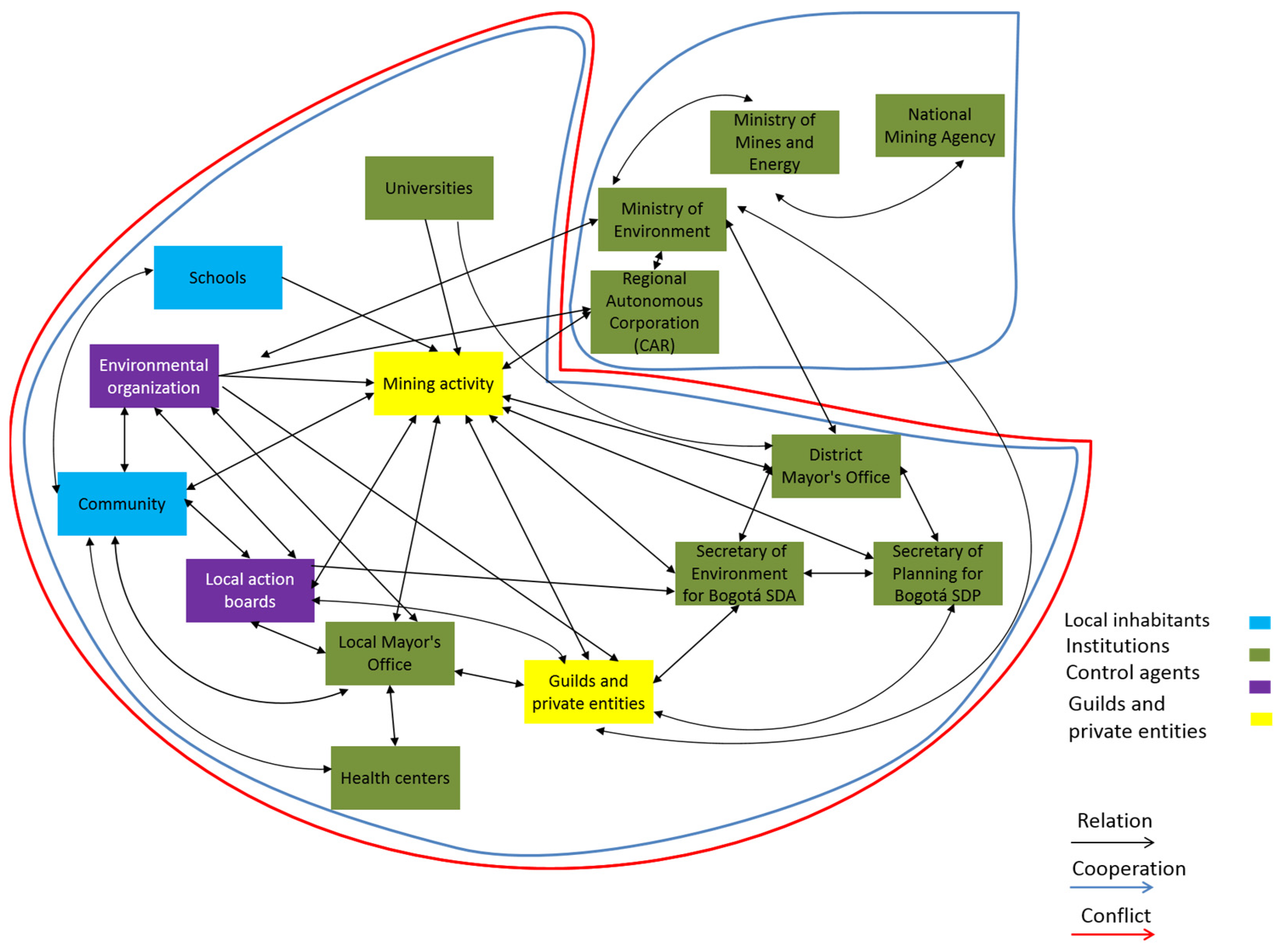
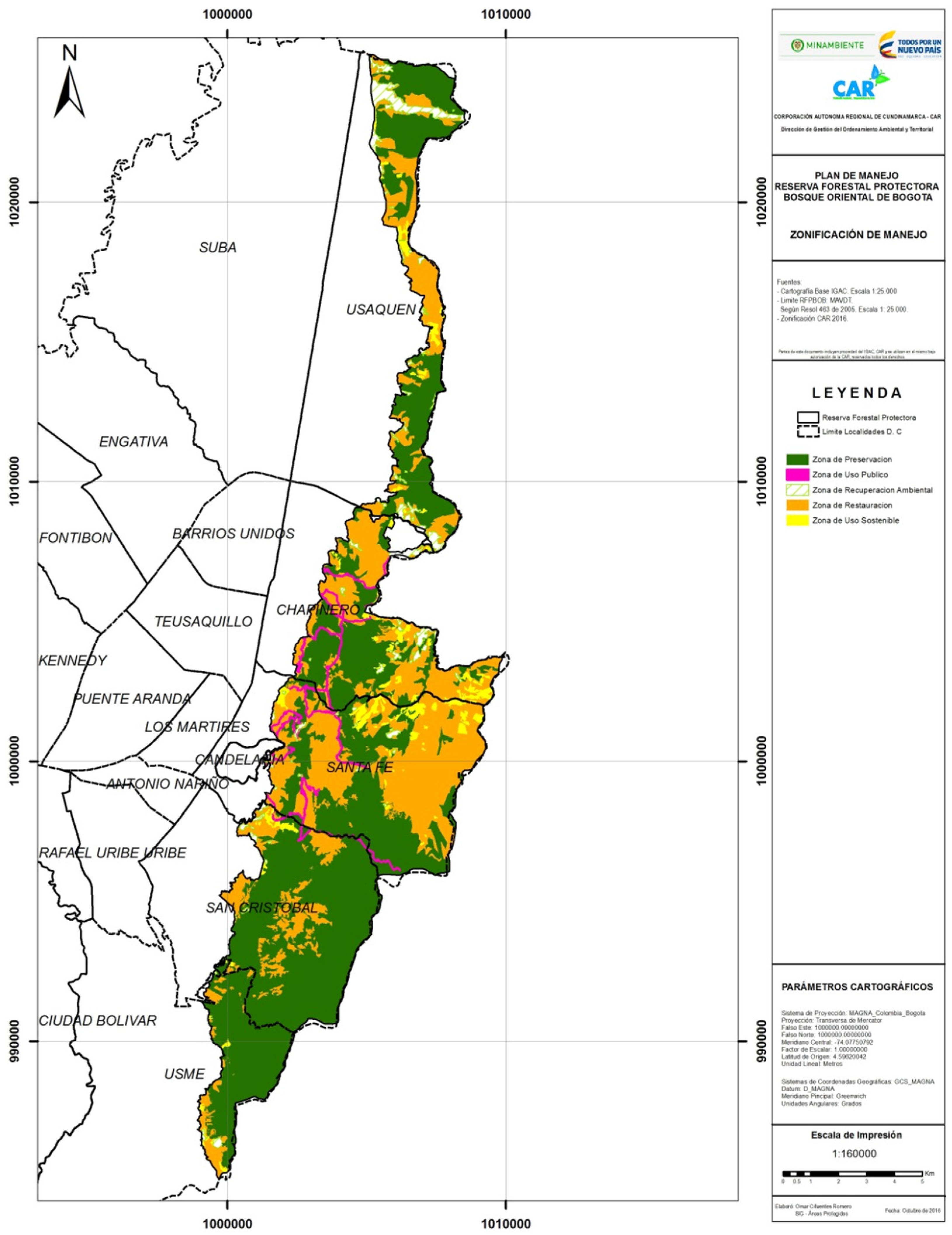
Disclaimer/Publisher’s Note: The statements, opinions and data contained in all publications are solely those of the individual author(s) and contributor(s) and not of MDPI and/or the editor(s). MDPI and/or the editor(s) disclaim responsibility for any injury to people or property resulting from any ideas, methods, instructions or products referred to in the content. |
© 2024 by the authors. Licensee MDPI, Basel, Switzerland. This article is an open access article distributed under the terms and conditions of the Creative Commons Attribution (CC BY) license (https://creativecommons.org/licenses/by/4.0/).
Share and Cite
Guzmán, A.H.; Hernández Guzmán, D.; Milanés, C.B.; Ramírez, O.; Herrera Tapias, B.; Montero, O.P.; Gutiérrez Reyes, A.; Zielinski, S. Community-Based Participatory Research on Urban Environmental Conflicts: Sand Quarries in Northern Bogotá. Land 2024, 13, 1460. https://doi.org/10.3390/land13091460
Guzmán AH, Hernández Guzmán D, Milanés CB, Ramírez O, Herrera Tapias B, Montero OP, Gutiérrez Reyes A, Zielinski S. Community-Based Participatory Research on Urban Environmental Conflicts: Sand Quarries in Northern Bogotá. Land. 2024; 13(9):1460. https://doi.org/10.3390/land13091460
Chicago/Turabian StyleGuzmán, Adriana Hernández, Diego Hernández Guzmán, Celene B. Milanés, Omar Ramírez, Belinha Herrera Tapias, Ofelia Pérez Montero, Atenas Gutiérrez Reyes, and Seweryn Zielinski. 2024. "Community-Based Participatory Research on Urban Environmental Conflicts: Sand Quarries in Northern Bogotá" Land 13, no. 9: 1460. https://doi.org/10.3390/land13091460
APA StyleGuzmán, A. H., Hernández Guzmán, D., Milanés, C. B., Ramírez, O., Herrera Tapias, B., Montero, O. P., Gutiérrez Reyes, A., & Zielinski, S. (2024). Community-Based Participatory Research on Urban Environmental Conflicts: Sand Quarries in Northern Bogotá. Land, 13(9), 1460. https://doi.org/10.3390/land13091460










